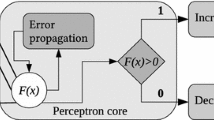Abstract
In the Internet, network congestion is becoming an intractable problem. Congestion results in longer delay, drastic jitter and excessive packet losses. As a result, quality of service (QoS) of networks deteriorates, and then the quality of experience (QoE) perceived by end users will not be satisfied. As a powerful supplement of transport layer (i.e. TCP) congestion control, active queue management (AQM) compensates the deficiency of TCP in congestion control. In this paper, a novel adaptive traffic prediction AQM (ATPAQM) algorithm is proposed. ATPAQM operates in two granularities. In coarse granularity, on one hand, it adopts an improved Kalman filtering model to predict traffic; on the other hand, it calculates average packet loss ratio (PLR) every prediction interval. In fine granularity, upon receiving a packet, it regulates packet dropping probability according to the calculated average PLR. Simulation results show that ATPAQM algorithm outperforms other algorithms in queue stability, packet loss ratio and link utilization.
Similar content being viewed by others
References
Bohacek, S., Shah, K., Arce, G. R., & Davis, M. (2004). Signal processing challenges in active queue management. IEEE Signal Processing Magazine, 21(5), 69–79.
Braden, B., Crowcroft, J., Davie, B., Deering, S., Estrin, D., Floyd, S., Jacobson, V., Minshall, G., Partridge, C., Peterson, L., Ramakrishnan, K. K., Shenker, S., Wroclawski, J., & Zhang, L. (1998). Recommendations on queue management and congestion avoidance in the Internet. RFC2309.
Floyd, S., & Jacobson, V. (1993). Random early detection gateways for congestion avoidance. ACM/IEEE Transactions on Networking, 1(4), 397–413.
Jain, A., Karandikar, A., & Verma, R. (2004). Adaptive prediction based approach for congestion estimation (APACE) in active queue management. Computer Communications, 27(16), 1647–1660.
Wang, J., Song, M., & Yang, H. (2006). Rate–based active queue management for congestion control over wired and wireless links. In IEEE ChinaCom’06, Beijing, China, 25–27 Oct., pp. 1–6.
Wang, C., Li, B., Hou, Y. T., Kazem, S., & Long, K. (2005). A stable rate-based algorithm for active queue management. Computer Communications, 28(15), 1731–1740.
Wang, C., Li, B., & Hou, Y. T. (2004). Design and analysis of a rate-based algorithm for active queue management. In 29th annual IEEE international conference on local computer networks, Tampa, FL, USA, 16–18 Nov., pp. 206–213.
Hong, J., Joo, C., & Bahk, S. (2007). Active queue management algorithm considering queue and load states. Computer Communications, 30(4), 886–892.
Ryu, S. (2004). PAQM: an adaptive and proactive queue management for end-to-end TCP congestion control. International Journal of Communication System, 17, 811–832.
Aweya, J., Ouellette, M., Montuno, D. Y., & Felske, K. (2006). Rate-based proportional-integral control scheme for active queue management. International Journal of Network Management, 16, 203–231.
Hollot, C. V., Misra, V., Towsley, D., & Weibo, G. (2002). Analysis and design of controllers for AQM routers supporting TCP flows. IEEE Transactions on Automatic Control, 47, 945–959.
Sun, J., Chen, G., Ko, K.-T., Chan, S., & Zukerman, M. (2003). PD-controller: a new active queue management scheme. In IEEE GLOBECOM’03, Dec., 2003 (vol. 6, pp. 3103–3107).
Feng, W., Kandlur, D. D., Saha, D., & Shin, K. G. (1999). Self-configuring RED gateway. In IEEE INFOCOM 99’, New York, March 1999, pp. 1320–1328.
Christiansen, M., Jeffay, K., Ott, D., & Smith, F. (2001). Tuning RED for web traffic. IEEE/ACM Transaction on Networking, 9(3), 249–264.
Floyd, S., Gummadi, R., & S. Adaptive RED, Shenker an algorithm for increasing the robustness of RED’s active queue management. www.icir.org/floyd/papers/adaptiveRed.pdf.
Ott, T. J., Lakshman, T. V., & Wong, L. H. (1999). SRED: stabilized RED. In IEEE INFOCOM’99, New York, pp. 1346–1355.
Athuraliya, S., & Low, S. H. (2000). Optimization flow control, II: random exponential marking. http://netlab.caltech.edu/pub.html.
Gao, W., Wang, J., Chen, J., & Chen, S. (2005). PFED: A prediction-based fair active queue management algorithm. In International conference on parallel processing, 2005. (ICPP 2005), 14–17 June 2005, Oslo, Norway, pp. 485–491.
Wu, Q., Tao, J., & Yao, J. (2006). An active queue management algorithm based on predictable PI controller in self-similar network. Acta Electronica Sinica, 34(5), 938–942.
Misra, V., Gong, W., & Towsley, D. (2000). Fluid-based analysis of a network of AQM routers supporting TCP flows with an application to RED. In ACM SIGCOMM’ 2000, Stockholm, Sweden, 151–160.
Li, J., Hou, X., & Han, Z. (2007). Application of Kalman filter and wavelet in traffic prediction. Journal of Electronics and Information Technology, 29(3), 725–728.
Wang, C., Li, B., Hou, Y. T., Sohraby, K., & Lin, Y. (2004). LRED: A Robust active queue management scheme based on packet loss ratio. In IEEE INFOCOM’04, pp. 1–12.
Willinger, W., Taqqu, M. S., Sherman, R., & Wilson, D. V. (1997). Self-similarity through high-variability: Statistical analysis of Ethernet LAN traffic at the source level. IEEE/ACM Transactions on Networking, 5(1), 71–86.
Yao, S., Hu, C., & Sun, M. (2006). Prediction of web traffic based on wavelet and neural network. In The sixth world congress on intelligent control and automation, 2006 (WCICA 2006) (vol. 1, pp. 4026–4028).
Mao, G., & Liu, H. (2007). Real time variable bit rate video traffic prediction. International Journal of Communication Systems, 20, 491–505.
Yin, H., Lin, C., Sebastien, B., Li, B., & Min, G. (2005). Network traffic prediction based on a new time series model. International Journal of Communication Systems, 18, 711–729.
Shu, Y., Jin, Z., Zhang, L., Wang, L., & Yang, O. W. W. (1999). Traffic prediction using FARIMA models. In IEEE international conference on communications, 1999, Vancouver, Canada, 6–10 June 1999 (vol. 2, pp. 891–895).
Sage, A. P., & Husa, G. W. (1969). Adaptive filtering with unknown prior statistics. In Proceedings of joint automatic control conference (pp. 760–769).
Wang, C., Liu, J., Li, B., Sohraby, K., & Hou, Y. T. (2007). LRED: a robust and responsive AQM algorithm using packet loss ratio measurement. IEEE Transactions on Parallel and Distributed Systems, 18(1), 29–43.
Author information
Authors and Affiliations
Corresponding author
Rights and permissions
About this article
Cite this article
Na, Z., Guo, Q., Gao, Z. et al. A novel adaptive traffic prediction AQM algorithm. Telecommun Syst 49, 149–160 (2012). https://doi.org/10.1007/s11235-010-9359-2
Published:
Issue Date:
DOI: https://doi.org/10.1007/s11235-010-9359-2




